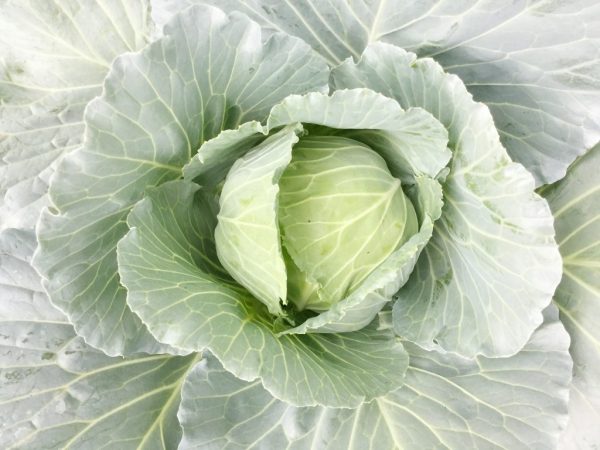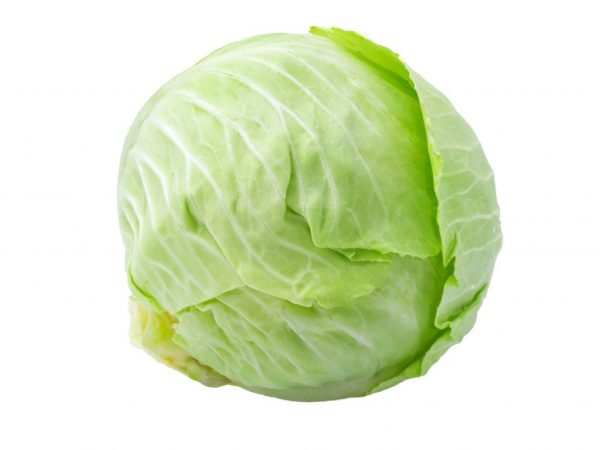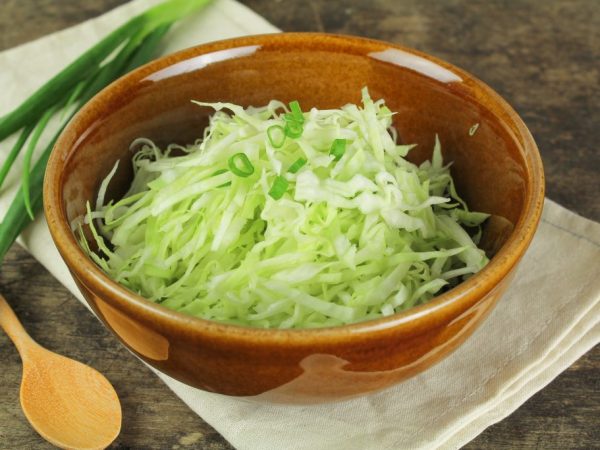Characteristics of Muksuma cabbage
Muksuma cabbage is a biennial plant that is suitable for long-term storage, transportation and processing.

Characteristics of Muksuma cabbage
Characteristics of the Muksuma variety
Muksuma is one of the varieties of late-ripening white cabbage.
The description of the culture is similar to that characteristic of other species, but has a number of features:
| Recommendations for use | Ripening period | Number of days of ripening | Head mass | Head density | Shelf life | Description of the fetus |
| Fresh look; Heat treatment | Late maturing | 135-140 | 2.4-3.5 kg | 4.6 points | Long | The head is round, dense, green in color, has a characteristic waxy coating. |
Late-ripening cabbage varieties are suitable for long-term storage and late sale. Muksum cabbage has a powerful root system, a rich green hue, dense soft leaves. Late varieties do not die during frosts, they are successfully used for salting.
Composition of Muksum cabbage
Cabbage contains minerals and fiber.
It has a positive effect on the body, thanks to provitamin A, B vitamins, vitamin U and vitamin C.
The chemical composition of the Muksuma variety:
- pantothenic and folic acid;
- phosphorus, zinc, aluminum;
- potassium salts;
- manganese, glucose, fructose;
- phosphorus, iodine.
Energy value of Muksum per 100 g: proteins 1.8; fats 0.10; carbohydrates 4.70. Caloric value per 100 g - 27 kcal.
Beneficial features

Muksuma variety improves metabolism
The head of cabbage leaves contain an important vitamin U, which fights against duodenal disease, as well as the manifestation of peptic ulcer disease. Due to this feature, cabbage leaves are processed and actively used in modern pharmacology.
Fresh consumption of the Muksuma variety helps to improve metabolism, strengthen blood vessels. Food fibers in green leaves trap cholesterol and bile acids, preventing them from being absorbed into the intestinal walls.
Vitamin C in the chemical composition of a vegetable has the most stable formula. This helps to maintain the beneficial effects of the vitamin after any heat treatment or fermentation. Muksum cabbage leaves have anti-inflammatory properties, have a beneficial effect on the activity of the heart system and regulate the production of gastric juice.
Application of Muksuma cabbage
In medicine
For a long time, the cabbage leaf was applied to the inflamed area, like a compress, leaving it overnight to relieve swelling and pain. Modern medicine uses vegetable leaves in the treatment of such diseases:
- peptic ulcer and gastritis;
- duodenum;
- tuberculosis;
- renal failure;
- spleen disease;
- ischemia;
- prevention of hypovitaminosis C.
Fresh juice of Muksum root vegetable is used for quick healing of wounds and minor burns. Vegetable stump is used in the fight against cancer. Muksuma is one of the prophylactic agents for depression and colds.
Contraindications
The vegetable is not suitable for people with colitis. It should not be included in the diet if the stomach is acidic.
In cooking

Cabbage is good fresh
Vegetable leaf does not require additional processing. It is great for raw cooking. The leaves are soft but crisp and perfect for any salad.
The leavening and pickling of a late-ripening variety is no different from other varieties. Heat treatment with other components is permissible. The variety does not have a pronounced smell and taste.
Storage and handling
Muksuma cabbage is a late-ripening variety, therefore it is suitable for long-term storage in specialized places or basements. Muksuma retains its taste and useful properties until the middle of winter, does not need additional processing.
The vegetable is able to withstand long-term transportation. With proper careful movement, the heads of cabbage do not lose their presentation.
Planting and growing varieties
Unlike other vegetables, Muksum cabbage is able to adapt to different climatic conditions. The root crop is unpretentious to the soil, so even heavy soil is suitable for planting. The variety is grown using seeds or seedlings.
How to choose the right seeds and seedlings
Choose a clean, dry, undamaged package with the full name of the crop and variety. Manufacturer, labeling, pariah number, legal address of the company, expiration date - everything must be indicated on the package.
F1 - special marking of hybrid plant varieties (only positive genetic predispositions). Packages with this marking contain selected, processed seeds.
The quality of seedlings when buying is determined by the appearance of the bush. The stems of Muksum cabbage should be thick and long, the leaves should be large.
Planting and leaving
Muksum cabbage seeds are sown in the first half of April. With late planting, the heads of the vegetable do not have time to form heads. Seedlings that have emerged after sowing can be transplanted into open ground after 46-50 days.
Before planting seedlings, the soil must be prepared:
- in the fall, dig up the prepared area without leveling: this way the earth will absorb the maximum amount of moisture;
- treat the soil with antiparasitic agents;
- water abundantly the day before planting;
- prepare the holes, mix the soil with peat fertilizer.
A young root crop is transplanted into the finished hole and sprinkled with dry earth. The seedlings are watered daily for 10 days. In the third and fourth week, each bush is spud. Ripe fruits are harvested in late autumn.
Conclusion
White cabbage is able to retain useful vitamins for a long time. The vegetable can be consumed in any form.
Muksum cabbage is unpretentious to weather conditions and bears fruit well. The head of cabbage is tight and juicy, suitable for long-term winter storage.


